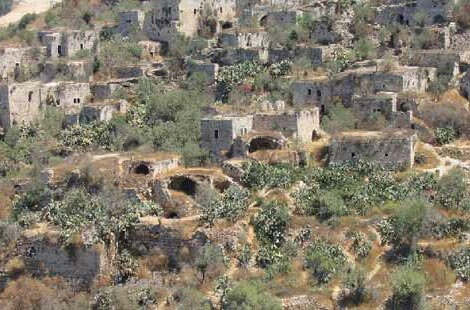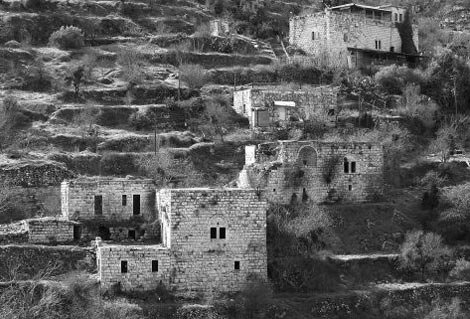Israel moves to turn deserted Palestinian village into luxury housing project
 Saturday, January 22, 2011 at 08:40PM
Saturday, January 22, 2011 at 08:40PM Israelis and Palestinians dedicated to the village Lifta’s preservation have called the plan to build 212 luxury units and a small hotel the end for the last Palestinian village of its kind.
IOA Editor: Yet another example of Palestinian history to be erased by Israel — this time, while not physically razed, it will be raped and pillaged by government planners and private developers. Even greater than the loss of the remarkable architectural beauty of the remnants of this village (which managed to escape Israeli bulldozers for 63 years) is the importance of the ‘big picture’ behind the story: Israel has methodically eradicated most of Palestine’s pre-1948 Palestinian history — the more than 400 conquered Arab villages it destroyed after 1948 — while reconstructing Palestine’s Jewish history. This is particularly true for Jerusalem, where the ‘battle of the narratives’ continues to be at the forefront of the Occupation.
See also APJP's petition: http://apjp.org/saving-lifta-a-case-against-a/
and signatories: http://apjp.org/signatories/
Other recent Jerusalem examples include the Shepherd Hotel and the ongoing struggle over the Mamilla Cemetery. Finally, as noted in the Hebrew version of the story, Lifta is located near Deir Yassin, the ultimate symbol of the Nakba.
Note: The header of the Hebrew version of the story is: “Palestinian memory monument to turn into prestigious neighborhood.”

Lifta, Jerusalem: Last visible remnant of the Nakba
By Nir Hasson, Haaretz – 21 Jan 2011
www.haaretz.com/print-edition/news/israel-moves-to-turn-deserted-palestinian-village-into-luxury-housing-project-1.338280
Yakub Odeh, 67, walks among the ruins of the Arab village of Lifta at the entrance to Jerusalem and is oblivious to the new neighborhoods and freeways that surround it. He doesn’t see the train tunnel being dug above it or the secret escape route for the country’s leaders being dug below.
Odeh doesn’t see the “Death to the Arabs” graffiti at the entrance to the village or the Arabic version of the name that someone blotted out on the sign there. He sees a village and an area as it existed until March 1948, before it was abandoned by its Palestinian residents.
“Ali Badr’s family lives here, and here’s Salah Mohammed’s house,” he says on a walk through Lifta. The village for him is not limited to the houses left standing around the well-known village spring. For him, it is also the remnants of houses in the Romema neighborhood of Jerusalem. the land on which new housing in Ramot was built. It is also the village school, which now serves as an ultra-Orthodox educational institution, at the entrance to Jerusalem.
“My roots are here. My whole mentality is from here. I will never be able to forget,” he says.
Now, the remains of the village are threatened by changes to the special character of the place. Two weeks ago, the Israel Land Administration published a public tender for construction in Lifta, which is to transform an abandoned Palestinian village on the edge of Jerusalem and a popular location for hiking into a luxury residential neighborhood. The developers have committed to preserve the houses and meticulously restore them. Plans call for the houses to become restaurants and galleries.
Odeh calls the redevelopment plan a second Nakba, Arabic for “catastrophe” and the word the Palestinians use to speak of the events surrounding the establishment of Israel in 1948.
Architect Gabriel Kertesz, who designed the new development in Lifta, together with Shmuel Groag and Shlomo Aronson, said the redevelopment is the best thing that could happen to Lifta.
“There is one approach that nothing should be done, which means the disappearance of the village. Our approach is one involving preservation and revival. The plan requires the most meticulous preservation rules and permits construction only after the historic buildings are preserved and everything is done under the supervision of the Antiquities Authority and a conservation architect,” he said.
Odeh is now involved in human rights work, but he is a former member of the Popular Front for the Liberation of Palestine who served a lengthy prison term. He was eight when his family fled Lifta. His former house overlooks the spring in the center of the village.
Lifta is an anomaly. Among the hundreds of Palestinian villages abandoned in 1948, it is the only one that was neither destroyed nor reinhabited. The villages of Ein Karem and Ein Hod, for example, remained standing but were inhabited by Jews.
Odeh and others see the remaining 55 homes in Lifta and the surrounding terraces as a kind of memorial to Palestinian society before Israel’s War of Independence. After the village was abandoned, the ceilings in the buildings were deliberately destroyed to deter intruders, however the homeless and others on the margins of society took up residence there.
One of the buildings houses a successful program for young drug addicts, which has been operating there for 20 years. The program’s director said yesterday that he doesn’t know what will become of the program once the redevelopment of the village begins.
In open areas around the existing homes in the village, plans call for 212 luxury housing units and a small hotel. Israelis and Palestinians dedicated to Lifta’s preservation have called the plan the end for the last Arab village of its kind.
Odeh said: “Our dream is that there be peace, and that we be able to return to our village.
There is enough room in Palestine for everyone. These are our homes. We were born here. We breathed the air here, and we are entitled to return here.”
Not all of the opponents of the proposed development share Odeh’s aspiration that he and descendants of other villagers return to live in Lifta. Architect Gadi Iron envisions Lifta as a world heritage site that should be preserved. He called it a “Garden of Eden” of streams and fruit trees and beautiful landscapes and a site containing important Palestinian architecture.
Iron said: “Lifta is more important than the Taj Mahal, from the standpoint of its beauty and for its Mediterranean heritage. The Taj Mahal is kitsch. In Lifta, there’s no kitsch.” He proposed the village be preserved as an architectural museum.
The complete IOA coverage of Lifta
 APJP |
APJP |  Post a Comment |
Post a Comment | 